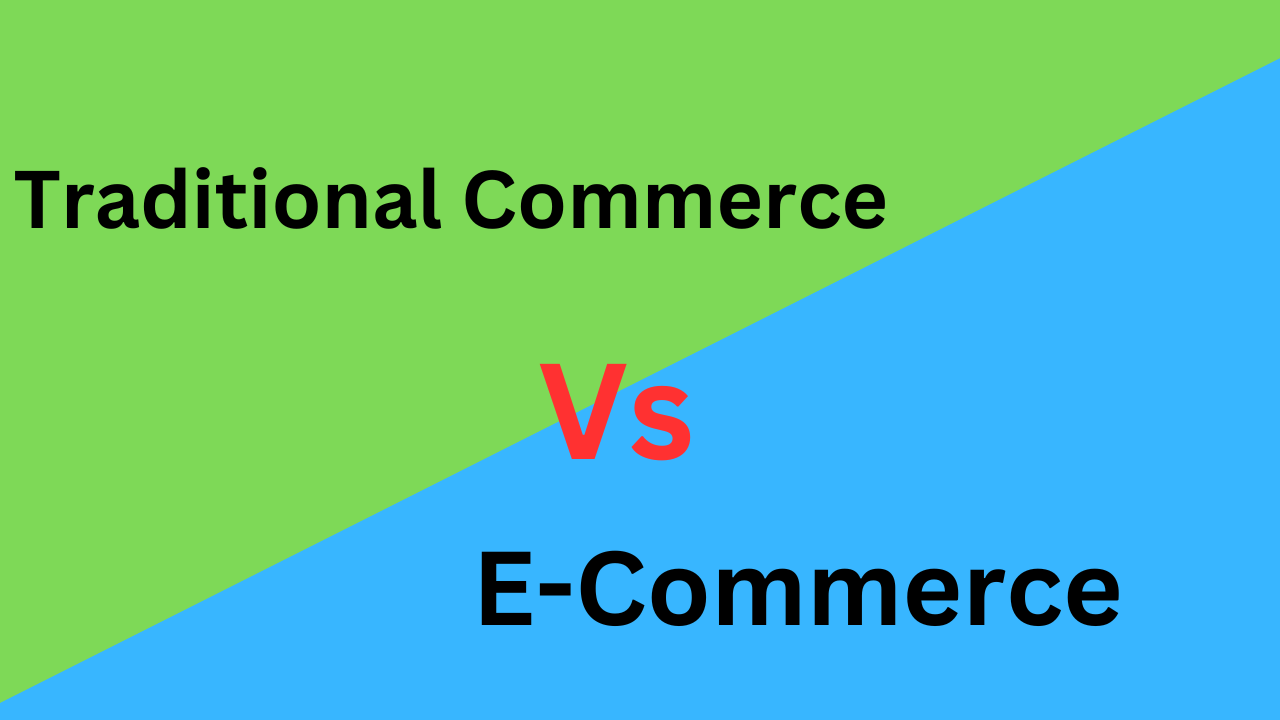What is the main difference between traditional commerce and E-commerce? Traditional commerce is a business activity that focuses on physical exchange of goods and services, while E-commerce is a commercial transaction that takes place electronically over the internet.
Commercial activities before technological advancement were involving physical exchange of goods and service for money between parties. But the development of E-commerce allowed people to buy goods, pay bills and transfer money at the comfort of their homes.
Many people in developing world prefer traditional commerce over e-commerce for safety myth related to the latter. Each type of commerce has its pros and cons. We wrote this comparison blog post to help you differentiate between e-commerce and traditional commerce.

Difference Between Traditional Commerce and E-Commerce With Table
| Basic Terms | Traditional Commerce | E-Commerce |
| Meaning | It is a branch of trade that entails physical exchange of goods and services. | It refers execution of commercial transaction or information exchange electronically over the internet. |
| Accessibility | Limited | Any time |
| Scope | Restricted to a definite area | Worldwide |
| Business Relationship | Linear | End-to-end |
| Marketing | One way | One to one |
| Payment | Cash, Debit or Credit card, cheque, etc., | Debit or Credit card, NEFT or Cash on Delivery (COD) etc., |
| Delivery of Products | Instantly | Takes some time |
| Processing of Transactions | Manual | Automatic |
| Physical inspection | Goods can be inspected physically before purchase. | Goods cannot be inspected physically before purchase. |
| Customer interaction | Face-to-face | Screen-to-face |
| Information exchange | No uniform platform for exchange of information. | Provides a uniform platform for information exchange. |
| Resource focus | Supply side | Demand side |
| Cost Effective | Lots of overhead costs from middlemen | Quite Cost effective |
| Chances of Fraud | Minimal risk | High risk |
| Time saving | Take lot of time to complete transactions | Saves to time |
What Is Traditional Commerce?
Traditional commerce refers to the conventional method of conducting business transactions that involve physical interactions between buyers and sellers. Payments are typically made using cash or physical forms of currency.
It encompasses the buying, selling, and exchange of goods and services through brick-and-mortar stores, markets, and face-to-face interactions. Customers browse physical stores, make purchases in person, and engage in direct negotiations with sellers.
Characteristics of Traditional Commerce
- Buyers and sellers interact in person at physical stores or markets.
- Transactions involve direct interpersonal communication.
- Businesses serve local or regional markets due to geographic constraints.
- Payments are made with physical currency like cash or checks.
- Customers can physically examine products before purchasing.
What Is E-Commerce?
E-commerce refers to the buying and selling of goods and services over the internet and electronic platforms. It involves online transactions, including browsing products, selecting items, making payments, and arranging for delivery, all carried out through digital channels.
E-commerce eliminates the need for physical presence to enable businesses operate on a global scale and customers to shop from anywhere with internet access. It encompasses various models like B2B (business-to-business), B2C (business-to-consumer), and C2C (consumer-to-consumer).
Characteristics of E-Commerce
- Goods and services are bought and sold via digital platforms on the internet.
- Businesses can operate internationally.
- E-commerce allows customers to shop and make transactions at any time.
- It encompasses various models like B2B, B2C, and C2C.
- Transactions are facilitated through electronic payment methods.
Main Difference Between Traditional Commerce and E-Commerce
- Traditional commerce entails face-to-face while e-commerce involves screen-to-face.
- Marketing in traditional commerce is one way while in e-commerce is one to one.
- Delivery of products in traditional commerce is instant while in e-commerce takes time.
- Business relation in traditional commerce is linear while e-commerce is end-to-end.
- Processing of transactions in traditional commerce is manual while e-commerce is automatic.
Similarities Between E-Commerce and Traditional Commerce
- Both involve interactions between buyers and sellers
- Both facilitate the buying and selling of products and services to meet consumer needs.
- Both are methods of conducting commercial transactions to generate revenue.
- Both aim to provide customers with satisfactory shopping experiences and quality products.
- Both contribute to the profitability of businesses by generating sales and revenue streams.
Final Thoughts from Experts
The distinctions between traditional commerce and e-commerce underline the dynamic evolution of business practices in our interconnected world. Traditional commerce thrives on physical interactions, direct negotiations, and localized markets. E-commerce leverages digital platforms to transcend geographical barriers, offering global accessibility and 24/7 convenience.
As the business landscape continues to evolve, understanding these differences becomes crucial for enterprises to adapt effectively, striking a balance between the time-honored principles of traditional commerce and the transformative potential of e-commerce.
People Who Read This Also Read:
- Difference between E-Commerce and E-Business
- Difference Between E-Commerce and M-Commerce
- Difference Between Goods and Services
- Difference between Wants and Needs